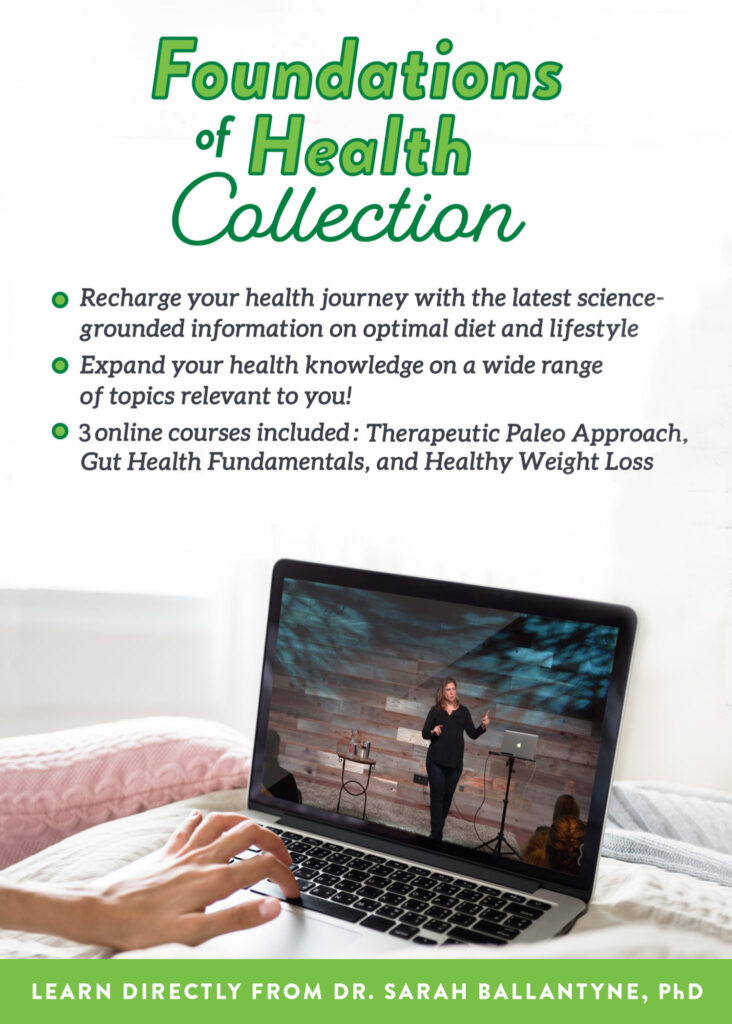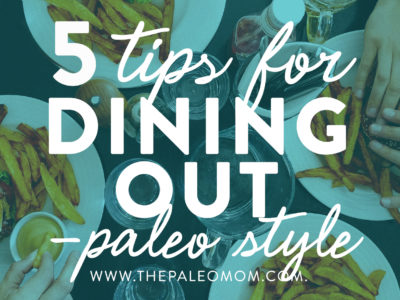When we’re new to following a Paleo diet or Autoimmune Protocol, eating at a restaurant might not be on the menu. But if you’re missing a meal that doesn’t have to be cooked in your own kitchen, never fear! It’s perfectly possible to dine out on a Paleo diet without blowing your budget, your goals or your social life. Follow these 5 time-honored tips to make dining out an enjoyable (and healthy!) experience.
Table of Contents[Hide][Show]
 1. Know Your Limits
1. Know Your Limits
One of the most wonderful things about the Paleo diet is the specific and actionable information it gives us about our own health. I’m fond of explaining Paleo as a framework to provide us with guidance in identifying those foods with which we thrive versus those foods that our bodies tolerate. Sustainability comes from living somewhere between those two boundaries: when life is stressful or we’re recovering from illness, that’s a time to tighten up our choices and stick with those foods that work best for our bodies; and when we’re on vacation or celebrating a special occasion, that’s a time to walk the line of what our bodies tolerate. True, discovering each of our limits can take time, but that knowledge is incredibly powerful for navigating not just restaurants, but the full gamut of social situations and travel, while successfully preserving our health.
Through elimination and reintroduction, I have been able to determine exactly which foods cause me discomfort (or worse, a flare!) and which are “worth” the occasional indulgence (see Reintroducing Foods after Following the Autoimmune Protocol and Making Healthy Choices: What’s Your Currency?) . This is all part of determining what “grey area foods” look like for me (see Gray Area Foods and 5 Ways You’re Doing Paleo Wrong). I know that I can eat white rice, for example, but that nightshades cause me joint pain that can last weeks after eating them just once (see What Are Nightshades? and The WHYs behind the Autoimmune Protocol: Nightshades).
I use these guidelines at home, of course, but they serve me especially well when dining out. I can use them to explain to the wait staff what I want to eat and what I don’t. I can use them to determine when an indulgence is okay, and when it will throw off my day or week too much to be a good decision. It’s not about willpower, but about making the best decisions for my body on any given day—and I love that!
Save 80% Off the Foundations of Health
Expand your health knowledge on a wide range of topics relevant to you, from how to evaluate scientific studies, to therapeutic diet and lifestyle, to leaky gut and gut microbiome health, to sustainable weight loss, and much more!!!

2. C hoose Your Restaurant With Care
hoose Your Restaurant With Care
Knowledge is power! Having a great list of local restaurants with Paleo-friendly options is a perfect strategy that can help us balance our cooking at home with the occasional indulgence. There’s a level of comfort associated with knowing a menu and being able to order your favorite dish with confidence.
When we’re traveling, using the internet to research Paleo or Gluten-free options is well worth our time, too! Often, sites like FindMeGlutenFree.com can help build a list of recommendations, and reviews from other patrons are often very useful. Recently, my friend Eileen of Phoenix Helix put together a fabulous list of every dedicated Paleo restaurant in the world—and she’s still adding to the list! Bookmark this incredible resource for future use.
In general, burger joints, salad bars, steakhouses, Mexican, Mediterranean, Thai, and Vietnamese cuisines tend to be very Paleo-friendly options. It’s also worth exploring restaurants with “farm-to-table” labels as well, as food quality tends to be a priority there and gluten-free menus are more common. Just be sure to ask questions ahead of time, let your waitstaff know about any allergies or restrictions, have your waitstaff check with the kitchen that your choice can be made to accommodate your restrictions before finalizing your order, and double check if anything seems fishy. Don’t be afraid to (politely) send something back to the kitchen if it doesn’t meet your expectations.
 3. Focus on Veggies
3. Focus on Veggies
Nutrient density is the most important principle we can apply to all our meals, regardless of their location. By focusing on making ¾ of our plate vitamin and mineral-rich vegetables, it becomes much simpler for us to achieve this goal, even when dining out (for more, see The Importance of Nutrient Density and The Importance of Vegetables). Simply put, vegetables push less nutritious options off our plates.
When we’ve been following a Paleo template for a while, we might be surprised by how few veggies are included in a serving at your favorite restaurant! In this situation, the menu is our best friend. Don’t be afraid to get creative by adding and substituting servings of vegetables to reach your goals.
We might order a salad with added protein, replace the grains or bread in a dish with steamed vegetables, or ask for a sweet potato or regular potato instead of bread (remembering that even white potatoes are nutrient-rich vegetables! See Potatoes: Friend or Foe of Paleo?).
It’s also important to remember that in restaurants, industrially-produced seed oils are often the cooking fat of choice. Unless you are sure that the vegetables are cooked in butter (providing you tolerate butter) or olive oil (see Olive Oil Redemption: Yes, It’s a Great Cooking Oil!), asking for steamed veggies or a salad without dressing can be a better choice. This is where knowing our limits comes in! If we know that a small amount of canola or soy oil doesn’t bother us, dining out might be more manageable. If we’re particularly sensitive it’s important to take steps to mitigate our exposure. And yes, it’s perfectly normal to bring your own mini bottle of olive oil to a restaurant to dress your salad and veggies! I often take a small bottle of Fresh Pressed Olive Oil with me while traveling just for such an occasion!
 4. Look for Lean Protein
4. Look for Lean Protein
While it’s true that many restaurants around the country are increasingly focused on food quality, these places are still the exception to the rule. That often means that pasture-raised and grass-fed meats aren’t on the menu. Since we know that animals fed sub-optimal diets and raised with antibiotics store toxins in their fat, focusing on lean meat is a good strategy while dining out (see Paleo FAQ: Can I still do Paleo if I can’t afford or source grass-fed beef and organic produce?).
Keeping our healing Omega-3 to inflammatory Omega-6 ratio is a key tenet of a healing Paleo diet, and we should remember that most restaurants save money by using industrially-processed, inflammatory oils in their cooking (see Why Grains Are Bad — Part 2, Omega 3 vs. 6 Fats). With this in mind, any kind of fish, even farmed, is also a fabulous choice when eating out (see The Importance of Fish In Our Diets and The Mercury Content of Seafood: Should we worry?). Farmed salmon still has four times more Omega-3 fatty acids than Omega-6’s (to compare, wild has 10 to 300 times more, depending on variety); farmed tilapia has close between 1:1 and 1:2 ratio of Omega-3 to Omega-6 fatty acids; whereas chicken has between 20 and 45 times more Omega-6s than omega-3s. Yay for seafood!
 5. Allow Time to Test
5. Allow Time to Test
As with any reintroduction, it’s important to monitor ourselves closely after an experience eating outside the home—especially when it isn’t a normal indulgence. Remember that these symptoms may often present themselves in unexpected ways or delayed by several days (see Reintroducing Foods after Following the Autoimmune Protocol). A reaction might not just be gastrointestinal—brain fog, headaches, irritability, fatigue, swollen joints and many more symptoms can indicate an unhealthy reaction to a food. Make note of any changes after you eat at a new restaurant for the next week, just to be safe. And, even though it’s tempting, try not to dismiss any symptoms of a bad reaction out of a desire for that food/meal/restaurant to work for you. It’s easy to attribute amorphous symptoms like fatigue or brain fog to something else, like not getting a good night’s sleep, when the true culprit something we ate that’s just not working for us.
It’s also important to understand that even if we think we that gluten is our only true issue and it’s safe to indulge in anything else, our bodies may see things differently. The principle of gluten cross-reactivity means that our bodies can sometimes react to foods that “look” like gluten, which has the potential to increase the number of foods we’re sensitive to (see Gluten Cross-Reactivity: How your body can still think you’re eating gluten even after giving it up). I once had one reader refer to rice as “slow gluten”, which I thought was a very apt description of what a cross-reactivity reaction can feel like. So, Gluten-free treats may work for us in theory, but if we develop reactions after eating them, we may choose to make a different decision next time. By carefully monitoring reactions after eating out, we can add even more detailed knowledge to our list of “safe” spots.
Above all, it helps to remember that dining out is often as much about social connection and pleasure as it is about the food. That’s especially important to keep in mind when things spiral out of your control; for example, if you have no say in the the restaurant choice, or you arrive somewhere anticipating that they can accommodate your restrictions only to find out they can’t. So, if you’re limited in what items you can order off the menu, or even stuck eating an Wild Zora Bar from your bag to round out a boring salad while watching your friends chow down on foods you know you can’t eat (we’ve all been there), remember that it’s still okay to have fun! And then, chalk it up to a learning experience, because next time, you can use 5 tips in mind to ensure an enjoyable experience that enriches your life!









